【精品】人教版新目标七年级英语上册unit4单元教案
- 格式:doc
- 大小:124.00 KB
- 文档页数:10

人教版新目标七年级英语初一上册Unit4单元教案设计含教学反思Unit 4 Where's My Schoolbag?n:XXX the n of objects and training students' four basic language skills: listening。
speaking。
reading。
and writing。
By asking about the n of objects。
students will learn some new words related to household items and school suppliesXXX。
they will learn the usage of singular and plural nouns and the pronoun "they." The unit aims to XXX cleanliness。
tidiness。
and reasonable placement of items.Unit Objectives:1.Knowledge and Skills:Master new vocabulary related to objects。
such as table。
bed。
dresser。
bookcase。
sofa。
chair。
drawer。
plant。
bag。
alarm clock。
CD。
video。
video cassette。
hat。
etc.Proficiently use XXX such as in。
on。
under。
behind。
in front of。
near。
etc.Master the usage of Where XXX.Understand the XXX "they."Learn how to accurately describe the n of objects in English.Learn how to ask about the specific n of one's or others' objects.XXX describe and design a room in English.2.Process and Methods:Use task-based language XXX。

人教版新课标英语七上u4教学设计人教版新课标英语七年级上册第四单元的教学设计应该围绕单元主题“Where's my schoolbag?”展开,旨在通过本单元的学习,让学生能够掌握询问和描述物品位置的英语表达方式,同时培养学生的空间感和方向感。
教学目标:1. 知识与技能:- 学生能够理解并使用“where”来询问物品的位置。
- 掌握介词“in, on, under, behind”等来描述物品的具体位置。
- 能够听懂并使用简单的方位指令。
2. 过程与方法:- 通过情景对话和角色扮演,让学生在实际语境中运用所学知识。
- 利用图片和实物,帮助学生形成空间位置的直观印象。
3. 情感态度与价值观:- 培养学生的观察力和记忆力,通过寻找和描述物品位置的活动,提高学生的注意力。
- 鼓励学生在日常生活中注意物品的摆放,养成良好的整理习惯。
教学重点:- 掌握询问和描述物品位置的句型和词汇。
教学难点:- 正确使用方位介词来描述物品的具体位置。
教学准备:- 教学挂图,展示不同物品的位置。
- 实物,如书包、铅笔盒、书等,用于课堂活动。
- 录音设备,播放对话和指令。
教学过程:1. 导入(Lead-in)- 通过展示一张教室的图片,询问学生:“Where's theteacher's desk?”等,激发学生对位置的兴趣。
2. 呈现(Presentation)- 利用实物和图片,教授方位介词“in, on, under, behind”等,并让学生进行跟读。
3. 操练(Practice)- 分组进行角色扮演,一人描述物品位置,另一人根据描述找到物品。
- 利用教室内的物品,进行实际的方位描述练习。
4. 应用(Application)- 学生两两合作,一人藏物品,另一人根据提示找到物品。
- 完成课本中的相关练习题,巩固所学知识。
5. 产出(Production)- 学生绘制自己房间的平面图,并用英语描述房间内物品的位置。
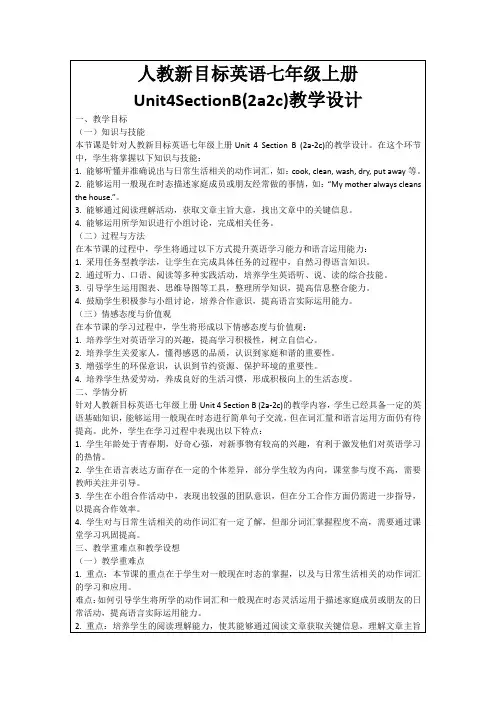
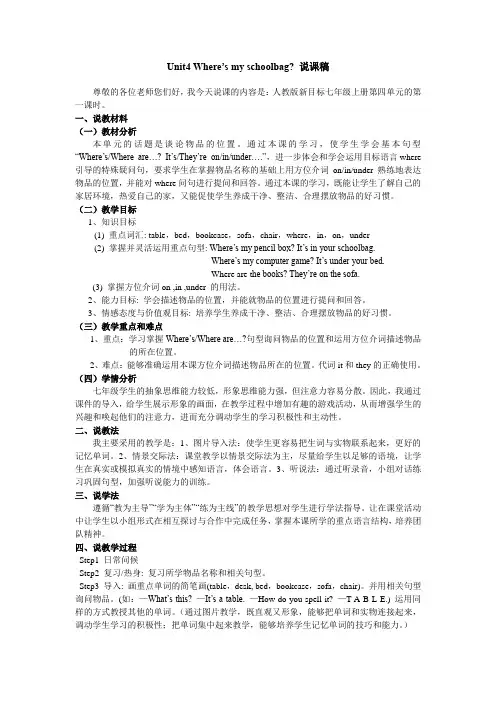
Unit4 Where’s my schoolbag? 说课稿尊敬的各位老师您们好,我今天说课的内容是:人教版新目标七年级上册第四单元的第一课时。
一、说教材料(一)教材分析本单元的话题是谈论物品的位置。
通过本课的学习,使学生学会基本句型“Where’s/Where are…? It’s/They’re on/in/under….”,进一步体会和学会运用目标语言where 引导的特殊疑问句,要求学生在掌握物品名称的基础上用方位介词on/in/under熟练地表达物品的位置,并能对where问句进行提问和回答。
通过本课的学习,既能让学生了解自己的家居环境,热爱自己的家,又能促使学生养成干净、整洁、合理摆放物品的好习惯。
(二)教学目标1、知识目标(1) 重点词汇: table,bed,bookcase,sofa,chair,where,in,on,under(2) 掌握并灵活运用重点句型: Where’s my pencil box? It’s in your schoolbag.Where’s my computer game? It’s under your bed.Where are t he books? They’re on the sofa.(3) 掌握方位介词on ,in ,under 的用法。
2、能力目标: 学会描述物品的位置,并能就物品的位置进行提问和回答。
3、情感态度与价值观目标: 培养学生养成干净、整洁、合理摆放物品的好习惯。
(三)教学重点和难点1、重点:学习掌握Where’s/Where are…?句型询问物品的位置和运用方位介词描述物品的所在位置。
2、难点:能够准确运用本课方位介词描述物品所在的位置。
代词it和they的正确使用。
(四)学情分析七年级学生的抽象思维能力较低,形象思维能力强,但注意力容易分散。
因此,我通过课件的导入,给学生展示形象的画面,在教学过程中增加有趣的游戏活动,从而增强学生的兴趣和唤起他们的注意力,进而充分调动学生的学习积极性和主动性。
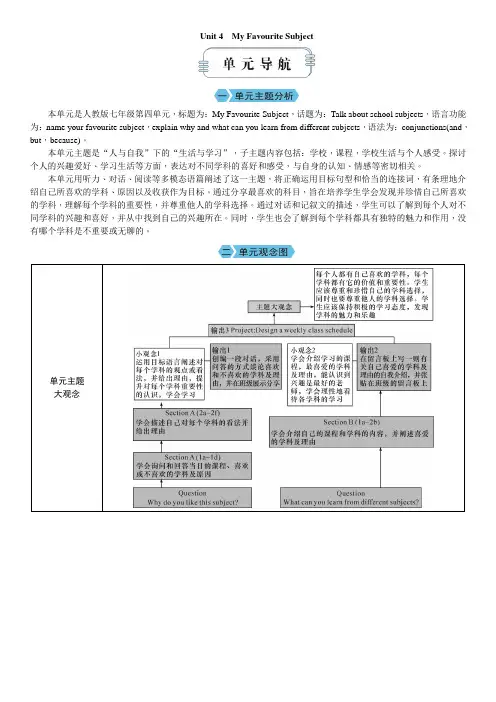
Unit 4 My Favourite Subject本单元是人教版七年级第四单元,标题为:My Favourite Subject,话题为:Talk about school subjects,语言功能为:name your favourite subject,explain why and what can you learn from different subjects,语法为:conjunctions(and,but,because)。
本单元主题是“人与自我”下的“生活与学习”,子主题内容包括:学校,课程,学校生活与个人感受。
探讨个人的兴趣爱好、学习生活等方面,表达对不同学科的喜好和感受,与自身的认知、情感等密切相关。
本单元用听力、对话、阅读等多模态语篇阐述了这一主题,将正确运用目标句型和恰当的连接词,有条理地介绍自己所喜欢的学科、原因以及收获作为目标。
通过分享最喜欢的科目,旨在培养学生学会发现并珍惜自己所喜欢的学科,理解每个学科的重要性,并尊重他人的学科选择。
通过对话和记叙文的描述,学生可以了解到每个人对不同学科的兴趣和喜好,并从中找到自己的兴趣所在。
同时,学生也会了解到每个学科都具有独特的魅力和作用,没有哪个学科是不重要或无聊的。
单元主题大观念单元语言大观念语言能力及技能语言能力:1.掌握与学科相关的词汇和常用表达,如:magic,useful,fun,important,subjects,difficult,easy,Chinese,history,maths,English,music,PE,geography,biology,IT,art,learn about the past,help me with my maths,work out maths problemsKey sentences:①—What's your favourite subject?—My favourite subject is…②—Why do you like…?—Because it's…③I'm good with numbers.④I'm not good at science.2.掌握双元音/e/,/a/,//,/əu/,/au/,/ə/,/eə/,/uə/的字母组合发音和单词连读。

人教版新目标七年级英语上册u n i t4单元教案本页仅作为文档页封面,使用时可以删除This document is for reference only-rar21year.MarchUnit 4 Where’s my schoolbag?教材解读本单元的主要内容是谈论物品所在的位置,通过这一话题和参与一些教学活动训练学生的听、说、读、写四项基本技能,让学生通过询问物品的位置,学习一些有关家居物品和学习用品的单词,以及方位介词in、on、under、behind等的用法;学习并掌握Where问句的问答,一般疑问句提问并用方位介词来回答;学习名词单复数及人称代词they的用法,同时培养学生养成干净、整洁、合理摆放物品的好习惯。
单元目标一、知识与技能1. 掌握有关物品的新单词:table、bed、dresser、bookcase、sofa、chair、drawer、plant、bag、alarm clock、CD、video、video cassette、hat 等。
2. 熟练运用in、on、under、behind、in front of、near等介词。
3. 熟练运用Where问句和一般疑问句及其回答。
4. 掌握名词单复数及人称代词they的用法。
5. 学会用英语准确描述物品所在的位置。
16. 学会用英语询问自己的或他人物品的具体位置。
7. 能够合理地描述和设计房间。
二、过程与方法采用任务型语言教学,实施情景教学法、交际法、情感激励法等教学方法。
三、情感态度与价值观1. 培养学生整齐地摆放自己物品的生活习惯。
2. 通过小组对话、讨论、调查和设计等一系列的课堂活动,培养学生的合作精神。
教法导航采用直观教学法,遵循以学生为主体,充分调动学生的积极性的原则。
学法导航培养学生的交际能力和认知能力。
课时支配第1课时:Section A 1a-1c第2课时:Section A 2a-3c第3课时:Section B 1a-1e,第4课时:Section B 2a-Self Check课时教案第1课时Section A1a-1c教学目标2一、知识与技能1. 方位介词:in、on、under、behind、in front of、near等的用法。
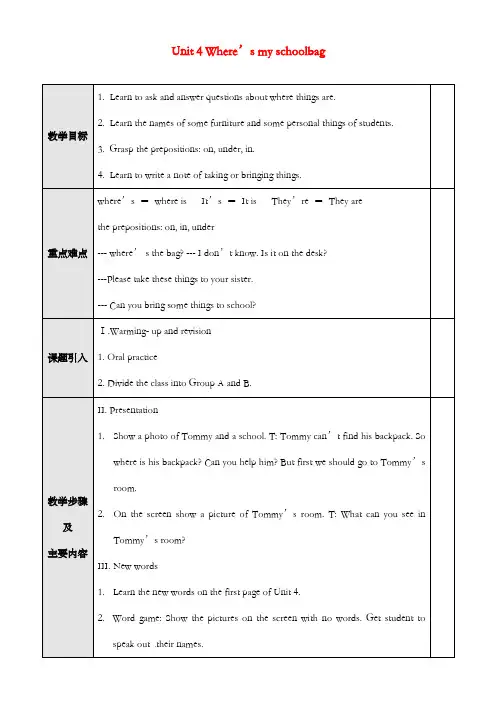
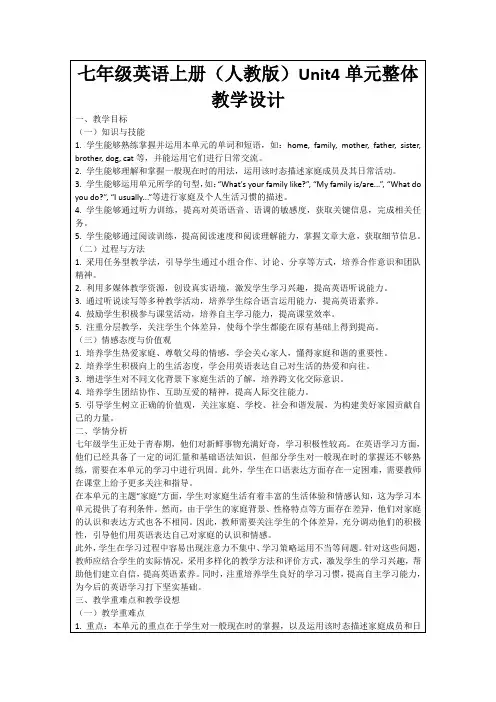
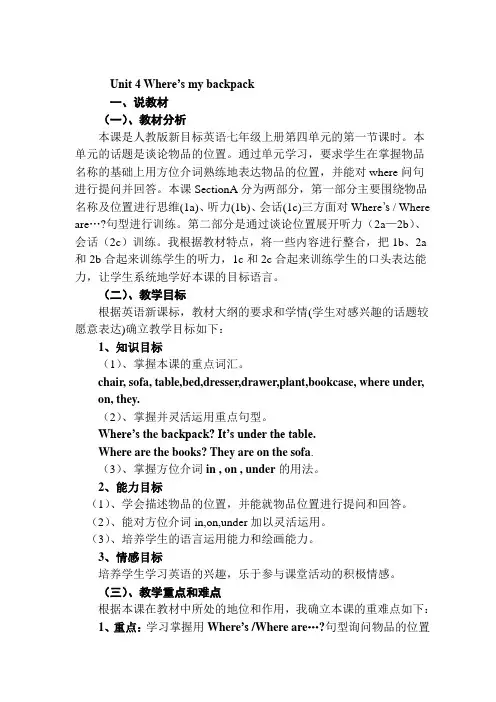
Unit 4 Where’s my backpack一、说教材(一)、教材分析本课是人教版新目标英语七年级上册第四单元的第一节课时。
本单元的话题是谈论物品的位置。
通过单元学习,要求学生在掌握物品名称的基础上用方位介词熟练地表达物品的位置,并能对where问句进行提问并回答。
本课SectionA分为两部分,第一部分主要围绕物品名称及位置进行思维(1a)、听力(1b)、会话(1c)三方面对Where’s / Where are…?句型进行训练。
第二部分是通过谈论位置展开听力(2a—2b)、会话(2c)训练。
我根据教材特点,将一些内容进行整合,把1b、2a 和2b合起来训练学生的听力,1c和2c合起来训练学生的口头表达能力,让学生系统地学好本课的目标语言。
(二)、教学目标根据英语新课标,教材大纲的要求和学情(学生对感兴趣的话题较愿意表达)确立教学目标如下:1、知识目标(1)、掌握本课的重点词汇。
chair, sofa, table,bed,dresser,drawer,plant,bookcase, where under, on, they.(2)、掌握并灵活运用重点句型。
Where’s the backpack? It’s under the table.Where are the books? They are on the sofa.(3)、掌握方位介词in , on , under的用法。
2、能力目标(1)、学会描述物品的位置,并能就物品位置进行提问和回答。
(2)、能对方位介词in,on,under加以灵活运用。
(3)、培养学生的语言运用能力和绘画能力。
3、情感目标培养学生学习英语的兴趣,乐于参与课堂活动的积极情感。
(三)、教学重点和难点根据本课在教材中所处的地位和作用,我确立本课的重难点如下:1、重点:学习掌握用Where’s /Where are…?句型询问物品的位置和运用方位介词in、on、unde r描述物品所在的位置。
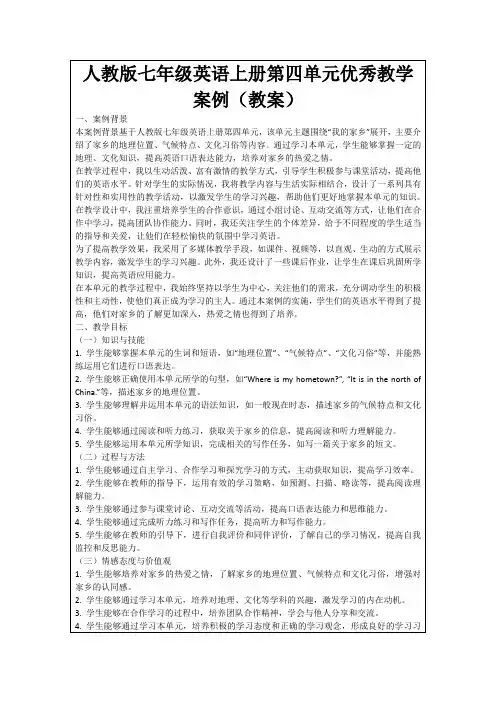
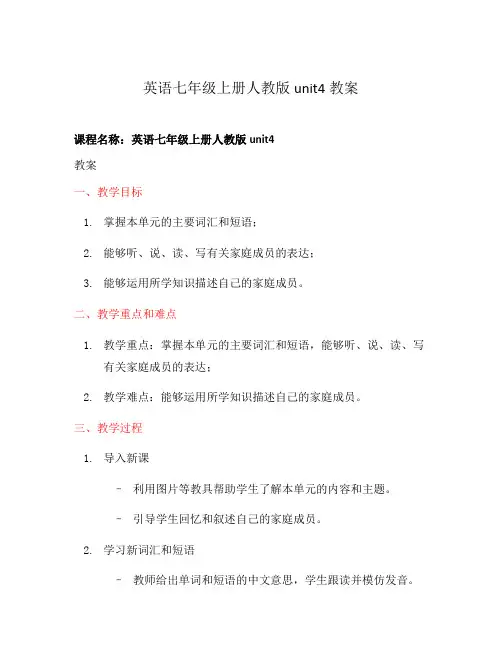
英语七年级上册人教版unit4教案课程名称:英语七年级上册人教版unit4教案一、教学目标1.掌握本单元的主要词汇和短语;2.能够听、说、读、写有关家庭成员的表达;3.能够运用所学知识描述自己的家庭成员。
二、教学重点和难点1.教学重点:掌握本单元的主要词汇和短语,能够听、说、读、写有关家庭成员的表达;2.教学难点:能够运用所学知识描述自己的家庭成员。
三、教学过程1.导入新课–利用图片等教具帮助学生了解本单元的内容和主题。
–引导学生回忆和叙述自己的家庭成员。
2.学习新词汇和短语–教师给出单词和短语的中文意思,学生跟读并模仿发音。
–利用图片和实物等教具帮助学生理解和记忆新词汇和短语。
3.听力训练–播放相关的听力材料,让学生听并回答问题。
–分组进行听力练习,让学生互相提问并回答。
4.口语训练–设计各种情景对话,让学生进行角色扮演,练习运用所学知识进行对话。
5.阅读训练–分发阅读材料,让学生阅读并回答问题。
–设计相关的阅读任务,让学生合作阅读,并互相询问答案。
6.书面表达–让学生运用所学知识,描述自己的家庭成员。
–提供范文和写作模板,帮助学生完成作文。
7.温故知新–设计一些小游戏和测试,复习本单元的知识和内容。
四、教学评价1.通过听、说、读、写的综合训练,评价学生对本单元知识的掌握情况。
2.设计相关练习和测试,对学生的能力进行评价。
五、教学资源1.课件及相关教具;2.单词卡片、图片和实物等教具;3.听力材料、阅读材料和相关练习题;4.范文和写作模板;5.小游戏和测试题。
六、拓展阅读•推荐学生找一些有关家庭成员的英语文章进行阅读,提高阅读能力和理解能力。
七、课后作业1.背诵本单元的重点词汇和短语;2.完成相关的听力和阅读练习题;3.完成书面作业,描述自己的家庭成员。
八、板书设计•Unit 4: My Family•Vocabulary: father, mother, brother, sister,grandparents, cousin, uncle, aunt•Phrases: in front of, next to, between, on the left/right of九、教学反思根据学生的实际情况和进度,灵活调整教学策略和教学内容。
【精选】人教版七年级上册英语Unit4第四单元优秀教案Unit 4 Where's my school bag?第一课时Section A(1a-1c)【学习目标】1.重点单词:where,table,bed,bookcase,sofa,chair,on,under 2.重点短语:on the sofa,in your bag,under your bed3.重点句型:—Where are my books?—They are on the sofa.—Where's my pencil box?—It's in your schoolbag.—Where's my computer game?—It's under your bed.【学习重点】1.能正确使用where引导的特殊疑问句2.用介词短语描述物品的位置【学习难点】1.能正确使用where引导的特殊疑问句2.用介词短语描述物品的位置【自主学习】一、预习课本P19新单词并背诵,完成下面的汉译英。
1.在哪里____________ 2.桌子____________3.床____________ 4.沙发____________5.椅子____________ 6.在……上________7.在……下__________二、认真预习1a,1b,1c,找出下列短语和句型。
1.在沙发上____________2.在你的书包里____________3.在你的床下____________4.—我的书在哪里?—他们在沙发上。
________________________________________________________________ _ 5.—我的铅笔盒在哪里?—它在你的书包里。
________________________________________________________________ _ 6.—我的电子游戏在哪里?—在你的床下。
Unit 4 Where’s my schoolbag?Period one (Section A 1a – 1c)Topic:Talk about where things areTeaching Objectives:1. Language objectives:1) Talk about where things are.2) Inquire where things are.3) Learn and grasp the usage of the preposition“on, in, under”4) V ocabulary:where, table, bed, bookcase, sofa, chair, schoolbag, pencil box,computer game, in, on, under;5) Target language: Where’s the schoolbag?Where’re my books?It’s on the table.It’s in your schoolbag.They’re under the sofa.2. Ability objectives:After the class students should be able to:1) inquire and talk about where things are using the key vocabulary and the targetlanguage learned in this class.2) gain some basic communicative competence.3) gain some basic ability of listening, and speaking.3. Moral objectives:1) Promote students to have a basic understanding of their and other people’s living environment, then to love their home, and to develop good living habits.2) Cultivate students' interests in learning English, and then they will be willing to participate in the classroom activitiesTeaching Important Points:1.where questions2.the usage of the preposition“on, in, under”.Teaching Difficult Points:1. the plural forms of where questions..2.the usage of the preposition“on, in, under”“and”.Teaching Methods1. Practice.2. Pair work.3. Group workTeaching Aids:multi-media, recorder, chalk, books, teaching design :Step 1: Greetings and revision1)daily greetings: Greet students using the sentences they have learnt so far. e.g. Hello! Nice tomeet you. How are you? etc.2)Revise “Is this your ruler?Yes, it is. It’s mine.Are those your erasers?No, they aren’t. They are hers.”Step 2:Lead-in and new words introduction1) First, teacher takes out a pen and asks studentsT: What’s this in English?S: It’s a pen..T: Can you spell it?S: Yes, P-E-N, pen.T: Good, thank you.2) Then, teacher shows a picture of a table and asks: “And w hat’s this in English, do you know?”S…T: You don’t know, right? It’s a table.Then, teacher introduces and teaches students to read the new word”table”with the help of the pictures showed on multi-media.(Introduce the new words “bed, sofa, bookcase, chair, schoolbag, pencil box, computer game” in the same way)3) Students work in groups and discuss the pronunciation of the new words, and then the teacher invites two students to teach the new words, the other students read after the student s.4) Students read the new words together.5) Students do section A, 1a. Match the words with the words in the picture.(Students first do it independently, then work in their own group and discuss, finally check answers )Step 3: Introduction of the preposition“on, in, under”(1)With the help of the multi-media, show the new preposition “on, in, under” to students.(2)Use the real objects, for example, a box and a pen to show the different meaning of “on, in, under”Step 4: Presentation and practice of the structure“Where’s sth. It’s i n/on/under...”1)Show a video of “Tom and Jerry”(猫和老鼠)and introduce them to students: “This is Tom, and that is Jerry. In the video, we can see the cat chases after the mouse, why can’t the cat catch the mouse? Yes, because the mouse escapes and hides in somewhere.”T: Now let’s see where Tom is.(Show the first picture, the mouse is on a box)T: Where’s Tom?S:…(Help students to answer “It’s on the box.”)(Show the second picture, the mouse is in a box)T: How about this one? Where’s Tom?S:It’s in the box.(Show the third picture and ask and answer in the same way)2) Students work in pairs and practice the structure “Where’s sth. It’s i n/on/under...”e, then show their dialogues. (With the help of teacher’s pictures)Step 5: Presentation and practice of the structure“Where’re sth. They’re i n/on/under...”1)Show a picture of some keys that are on the table.T:Where’re the keys?S:…(Help students to answer “they’re on the desk.)(Show another picture of some keys that are under the table.)T: Where’re the keys?S: They’re under the desk(Show the third picture of some keys that are in the desk)T: Where’re the keys?S: They’re in the desk.2)Students work in pairs and practice the structure, then show their dialogues. (With the help ofteacher’s pictures)Step 6: Read the dialogue in Section A, 1a, and role play.1)Students read after the tape.2)Read the dialogue in 1a together.3)The whole class is divided into two groups, and then role play the dialogue.Step 7: Listening. Do section A, 1b.1)Students listen to the tape for the first time.2)Check answers.3)Students listen to the tape for the second time with the answers and try to repeat.Step 8: A small quiz1、我的书在哪里?在沙发上。
人教版英语精品资料Unit 4 Where’s my schoolbag?教材解读本单元的主要内容是谈论物品所在的位置,通过这一话题和参与一些教学活动训练学生的听、说、读、写四项基本技能,让学生通过询问物品的位置,学习一些有关家居物品和学习用品的单词,以及方位介词in、on、under、behind等的用法;学习并掌握Where问句的问答,一般疑问句提问并用方位介词来回答;学习名词单复数及人称代词they的用法,同时培养学生养成干净、整洁、合理摆放物品的好习惯。
单元目标一、知识与技能1. 掌握有关物品的新单词:table、bed、dresser、bookcase、sofa、chair、drawer、plant、bag、alarm clock、CD、video、video cassette、hat等。
2. 熟练运用in、on、under、behind、in front of、near等介词。
3. 熟练运用Where问句和一般疑问句及其回答。
4. 掌握名词单复数及人称代词they的用法。
5.学会用英语准确描述物品所在的位置。
6.学会用英语询问自己的或他人物品的具体位置。
7. 能够合理地描述和设计房间。
二、过程与方法采用任务型语言教学,实施情景教学法、交际法、情感激励法等教学方法。
三、情感态度与价值观1. 培养学生整齐地摆放自己物品的生活习惯。
2. 通过小组对话、讨论、调查和设计等一系列的课堂活动,培养学生的合作精神。
教法导航采用直观教学法,遵循以学生为主体,充分调动学生的积极性的原则。
学法导航培养学生的交际能力和认知能力。
课时支配第1课时:Section A 1a-1c第2课时:Section A 2a-3c第3课时:Section B 1a-1e,第4课时:Section B 2a-Self Check课时教案第1课时Section A1a-1c教学目标一、知识与技能1. 方位介词:in、on、under、behind、in front of、near等的用法。
2.Where引导的特殊疑问句和一般疑问句Is the ... in/on/under the ...?的回答。
3. 新单词:bed、table、bookcase、chair。
二、过程与方法采用目标和任务教学法,调动学生的积极性,引导他们积极参与课堂。
三、情感态度与价值观提高认知能力。
教学重点1. 方位介词in、on、under、behind、in front of、near等的用法。
2.Where引导的特殊疑问句和一般疑问句Is the ... in/on/under the ...? 的回答。
3. 新单词:bed、table、bookcase、chair。
教学难点Where引导的特殊疑问句和一般疑问句Is the ... in/on/under the ...? 的交际。
教法导航明确任务,以学生为主体。
加强小组合作学习,积极回答问题。
教学准备PPT、部分学习用品的实物。
教学过程Step 1: GreetingsGreet the students as usual.Step 2:Warming upPlay an English song before class to interest the students.Revise some school things by asking questions.e.g.:What’s this?Is this a ...?How do you spell it? etc.Learn the new words in, on, under, behind ... by helping the teacher find the lost things.T:Where’s my English book?S1:It’s here./I think it’s ...T:Oh, it’s on the desk.…T:Where’re my color pencils?S2:...Teach the new word “where” and the use of “they”.Consolidate the prepositions by looking at the screen and answer the questions: Where’s ... ? Where’re ...?Step 3: GameStudents hide and look for the school things in pairs. One student hide one school thing and asks: Where’s…? Where’re…? The other student guess and answer: It’s in your desk. They are in your pencil case. etc. Ask some pairs to share their performances.Step 4: New words learningShow the students a picture of a room, tell them this is a bedroom and let the students list the things in it first. Then show them the whole picture, teach the new words, ask where the things are, and let the students answer, using the prepositions.Repeat with a sitting room and a study, teach the new words and practice in the same way.Step 5: 1a-1cWork on 1a Match the words with the things in the picture. Students do it individually first, then check the answers.Work on 1b play the tape for the students and ask them to number the things in the picture. Then ask one students to report the answers.Work on 1c Make up dialogues in pairs, using the things in the picture. Let two pairs show their dialoguesStep 6: A memory testShow a picture of a room, give the students one minute to look at it, then ask them what kind of things they saw and where the things are. Have a competition among groups. See which group can remember all the things and places.Step 7: HomeworkCopy the new words and try to remember them.Make a survey:Interview one of your friends.Fill in the form below.课堂作业( ) 1.Where _________ the CDs?A.isB.areC.amD.be( ) 2.——_________ my alarm clock? ——_________ on the bed.A.Where, ItB.Where’s, It’sC.Where are, They’reD.Where, It’s( ) 3._________ her hat on the sofa?A.IsB.AreC.CanD.Do参考答案:1.B 2.B 3.A教学反思本节课单词较多,因此最好采用实物或图片教学法来教这些新单词,这样更具有直观效果,所设计课堂环节一定要能激发学生的兴趣,本堂课所设计的游戏环节就非常好。
第2课时Section A2a-3c教学目标一、知识与技能1. 词汇:come、desk、think、room、their、hat、head、radio。
2. 熟练运用句型Where’s ...? Where are ...? 进行对话。
3.Develop the ability of making a conversation.二、过程与方法以教科书素材为载体,培养学生综合运用英语的能力。
三、情感态度与价值观培养合作精神,养成爱干净的习惯。
教学重点1. 词汇:come、desk、think、room、their、hat、head、radio。
2. 句型Where’s ...? Where are ...? 进行对话。
3.Develop the ability of making a conversation.教学难点Develop the ability of making a conversation.教法导航鼓励学生多说,培养他们的合作意识。
学法导航多听,积极参与。
教学准备PPT。
教学过程Step 1: GreetingsGreet the students as usual.Step 2: Warming upChatting.Chat with the students about the things around the room by showing them pictures. Ask the students to spell the new words.Step 3: Work on 2a-2b2a Revise what the things are. Ask the students to read the words aloud. Play the tape for students and let them number them.2b Play the tape again, the students number the things 1-6 in the picture. Imitate the dialogues.Step 4: PracticeA guessing game. Show the students a picture of a room with a few things in it. Have them guess the places of the other things.e.g.:T:There is a bookcase in it. Is the bookcase near the bed?Ss:Yes, it is./No, it isn’t.Write the general question and the answers on the blackboard.2c Look at the picture in 2b again. The students use general questions to ask and answer about the things in it.Step 5: Work on 3c Find the differenceStudent A looks at Picture 1 (Textbook P21). Student B looks at Picture 2 (Textbook P19 1a). Ask and answer in pairs and fill in the form.e.g.:SA:Where is the schoolbag? Is it under the table?Ask some students to report their answer like this:In Picture 1, the pencil case is ... In Picture 2, the pencil case is ..., In Picture 1, the books are ... In Picture 2, the books are ...Step 6: Practice the drill “Where is/are ...?”1.Work on 2d Role-play the conversation.Ask the students to read the dialogue in pairs and then let two pairs act it out. 2.Present short dialogues, using pictures or objects to help.Dialogue 1:A:Where’s my bag?B:I don’t know. Is it on the sofa?A:No, it isn’t.Dialogue 2:A:Where’re my books?B:I don’t know. Are they on the bed?A:Yes, they are.Teach “don’t=do not”, “know”.Let the students make similar dialogues according to the pictures in 3a and 3b. After they have finished the exercise, let one or two students report their answers. Step 7: HomeworkFinish off the exercises in the exercise books.Act out the dialogues.教学反思设计贴近学生实际的话题。